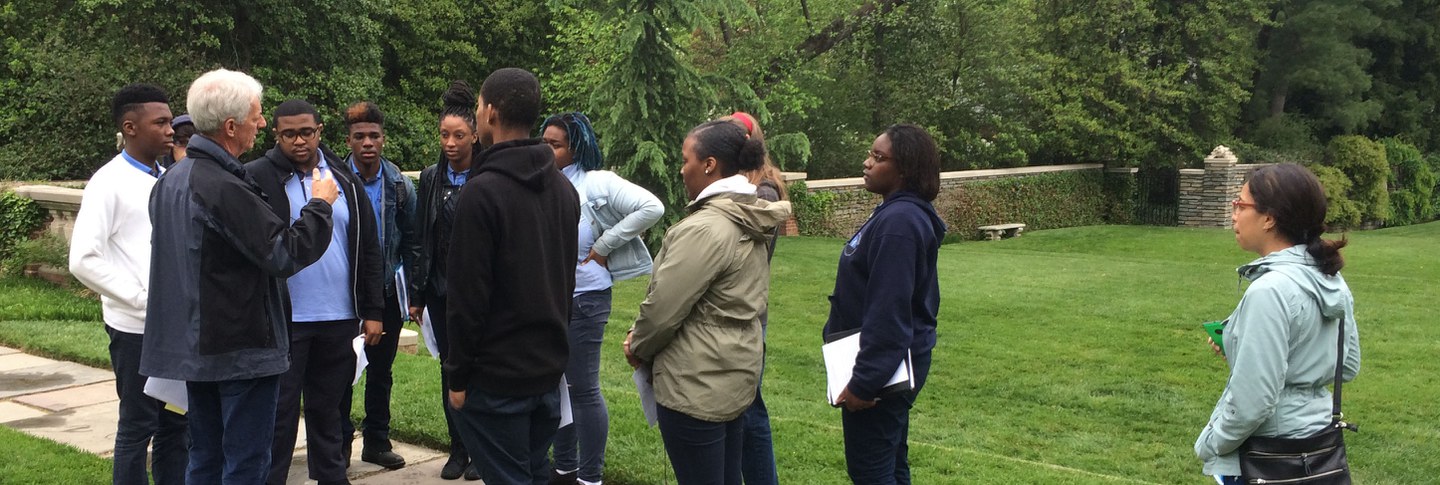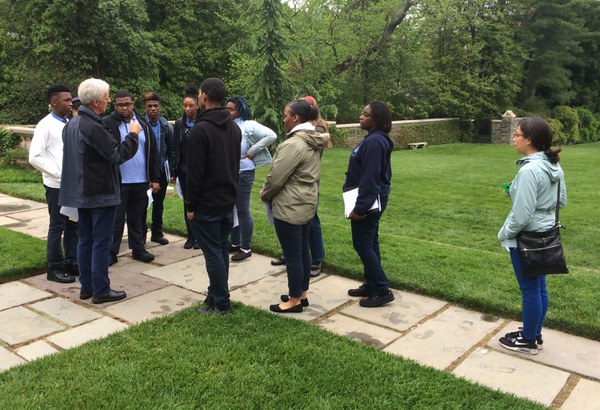By Jeanne Haffner, Mellon Postdoctoral Fellow in Urban Landscape Studies
The Mellon Initiative in Urban Landscape Studies is located on the tree-filled grounds of the historic gardens at Dumbarton Oaks. But its mission, as its name suggests, is to extend landscape studies into the city. In April and May, the program did this literally, launching its outreach program for students from underserved schools in Washington, D.C. Over a hundred students were given tours of the new LEED-certified Fellowship House, the recently designed pollinator garden by the Garden Court, and the historic gardens themselves.
The first of these workshops, titled “Biodiversity from Garden to City,” built upon the landscape and architecture curriculum at Phelps Architecture, Construction and Engineering High School, located in northeast Washington, D.C. Students toured the Dumbarton Oaks Gardens, paying particular attention to landscape design, topography, and water management, and met with Luís Mármol, gardener and horticulturalist. They were shown different types of plant beds—from the highly aesthetic Rose Garden to the more functional Kitchen Garden—and the Wilderness, an area located in the South Lawn, just before R Street, that serves to absorb water as well as to provide a contrast with more formal areas. Tyler fellow Deirdre Moore, who designed the new pollinator garden, discussed issues of water management as well as the connection between certain plants and the insects they attract. The field trip ended with a pop-up exhibit of Moore’s drawings and maps of the pollinator garden in the Lower Refectory, where students were given the opportunity to ask questions about the design process.

In May, we expanded outreach initiatives to include elementary school students through the D.C. Arts and Humanities Education Collaborative, a group that organizes field trips for public and public charter schools across the District. The “Tree Notebooks” workshop, given to fourth, seventh, and eighth graders from Achievement Prep in southeast Washington, D.C., introduced the basics of tree identification and emphasized the importance of trees in urban sustainability and well-being. Students were first asked to identify the uses of trees, ranging from wood and food to spiritual renewal in some cultures. Then they sketched particular trees in the garden—an exercise aimed at reinforcing some of the elements of tree identification as well as landscape design. Another workshop, “City of Trees,” was given to sixth graders from McKinley Middle School. Using the grounds of Dumbarton Oaks, students were shown various ways in which ecological issues enter the city, from gardens like the ones at Dumbarton Oaks to water management and biodiversity at the pollinator garden and LEED certification at the Fellowship House. Throughout the tour, students also paid particular attention the gardens’ topography and various strategies for controlling the flow of water from garden to park.

The National Building Museum’s Teen Council, a part of the museum’s Design Apprenticeship Program, came to Dumbarton Oaks in mid-May to explore design features, hydrology, and historical topography in the gardens and Dumbarton Oaks Park in a workshop called “Private Garden, Public Park.” As those familiar with Beatrix Farrand’s work know, the gardens and Dumbarton Oaks Park used to be connected, giving the visitor the experience of going from a manicured garden to a more “wild”—but just as designed—space. The more feral parts, which lay at the bottom of the hill by the creek, were given to the National Park Service in 1940, the same year that the gardens and museum collections were transferred to Harvard University. After an extensive tour of the gardens, students walked through the gate at the base of the Forsythia Dell to Dumbarton Oaks Park. They saw remnants from the pre-1940 era, including the stone bridge, dams along the creek, and stone benches along the path, and then imagined new transitions from garden to park.
Outreach is just one aspect of the Mellon grant, which was awarded by the Andrew W. Mellon Foundation's “Architecture, Urbanism, and the Humanities” initiative and runs through 2018. The program also provides fellowships for scholars working on urban landscape issues all over the world and organizes a variety of events aimed at encouraging interdisciplinary dialogue. The outreach component of the grant, however, is unique. It provides an opportunity to foster new collaborations between Dumbarton Oaks and outside organizations, such as the National Building Museum, and to rethink the gardens as the basis for a series of workshops on landscape and planting design, urban sustainability, and biodiversity in cities. In addition, preparing for these events drew together people inside Dumbarton Oaks, from the gardens staff and Garden and Landscape Studies program to the Director’s Office.
The Mellon Initiative in Urban Landscape Studies is excited to build on these workshops with more events next year with these and additional institutions. Extending scholarly research in urban landscape studies to students in secondary education occupies an important position in Dumbarton Oaks’ overall mission to support the humanities and serve the wider public and to find ways for local schools to use the gardens and museum as an educational resource. Dumbarton Oaks might have some very old relics in its possession but they are being looked at through younger and younger eyes.

